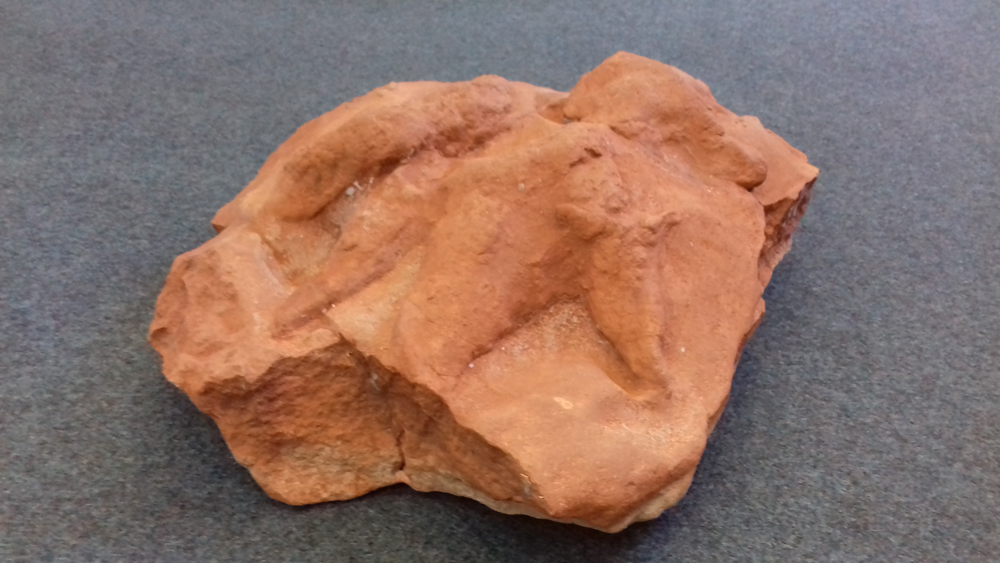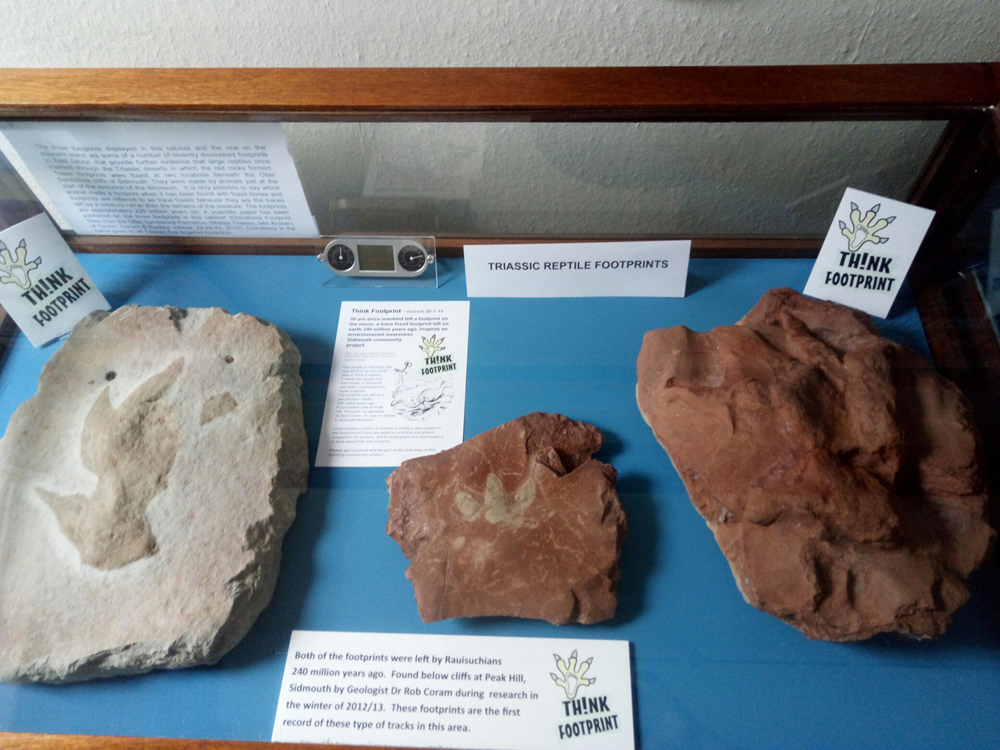“For me the greatest image is the footprint and it’s a very simple iconic image. Footprints are evocative things.
Why are we the way we are? One of the reasons is we began to walk upright in Africa and only 4 million years later there’s a footprint on the moon.
You juxtapose those two things and you see what we have managed to do as a species in a very short space of geological time.”
Dr Brian Cox, speaking in an interview for the ITV programme ‘The Day We Walked On The Moon’, broadcast Tuesday 16th July 2019
The Footprint – by Dr Rob Coram, palaeontologist, finder of the footprint
Where the rauisuchians lived would have been mostly a forbidding desert environment. However, running through it was a network of life-giving rivers, which laid down the Otter Sandstone, a bit like the Nile in Egypt today.
Often these rivers would have been bordered by fish-filled ponds, lakes, and shady forests, but there would have been droughts when virtually everything dried up and times would have been hard.

Just below the Otter Sandstone, where the prints are, are the famous Budleigh Salterton Pebble Beds. These pebbles were carried all the way from, what is now, Northern France by raging torrents caused by massive storms.
There would have been high hills visible. Because of the hot climate, these hills wouldn’t have been lushly forested, but more like the barren hills you see in American deserts, shimmering in a heat haze. If you crossed these hills and carried on west, you’d shortly arrive in America, which was joined onto Britain in those days.
The local trees would have been conifers and would have shed their leaves if they were dying. There was no grass, just ferns.
Rauisuchians were meat-eaters, with razor-sharp teeth that can be found at Sidmouth. The Sidmouth beasts, based on the size of the footprints, probably got to about five or so metres in length and would have looked like a cross between a crocodile and a dinosaur, and scaly. Most of the time they probably plodded about on all four legs but could stand and move upright.
The fossil footprints at Sidmouth are mostly from the larger hind feet. They are clawed and five-toed. One of the toes is usually bent backwards, rather like a human thumb, leading to these animals being nicknamed ‘hand beasts’ when they were first discovered in Germany almost two hundred years ago. The footprints can be common at some levels when low tide conditions are right. This suggests that they were herding animals perhaps migrating in search of food or water or a breeding ground.
It was exciting finding the footprints for the first time. I had to find several to be totally sure they weren’t just deceptive markings in the rock that resembled footprints.
I map and photograph them and then leave them, apart from the small numbers I ‘rescue’ for museums.

Trace fossils such as these are in many ways more exciting than bones because they were produced by living, breathing animals and so are tiny snapshots into their lives.
A FOOTPRINT FOR ETERNITY – by Isobel Francis, Sidmouth geologist.
As we look at the fossil footprint, it gives us a sense of awe, and makes us wonder about a past that we can only begin to imagine. What creature could have made this mark? Where would it have lived? What would it have eaten?
This fossil gives us a unique view into a few seconds, as long as a large reptile takes to make a footprint in a muddy swamp, as it ambles through its daily routine searching for food. Along with bones found nearby scientists can reconstruct its body. From this, conclusions can be drawn about its diet, habitat and ease of movement.
These creatures lived in a time of no human pollution. In fact, it would be roughly another 230,000,000 million years until we appeared on the scene. So there was no plastic, no fossil fuel emissions (after all coal, petroleum and diesel are 10’s of millions of years of precious fossilised swamp plant remains) to speed up melting of the ice caps. Cataclysmic events that happened, and they did happen, were only subject to the geological machine over 10’s to 100’s of millions of years.
But what of our own footprint for eternity? What will it show about us? Will it show our disregard for the wider environment, our inability to understand our role in the more powerful forces of climate change? Will it highlight the number of species that have become extinct under our guardianship due to the pollution of both land and sea?
It is important for everyone to understand the damage that our ‘throw away’ society is causing. And this enlightenment needs to happen at as early an age as possible. Children after all are our future and they need to retrain their parents and grandparents into more environmentally friendly practices like not accepting plastic bags, recycling as much as possible, and growing a few vegetables. If every family made just a tiny effort it would mean our fossil footprint.
“What trace do we leave to say that we were here?
Reach across time with a message that is clear
About “who” we were, how we spent our day
By our actions in life, what will our footprint say?”
Jo Earlam